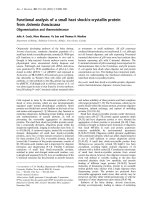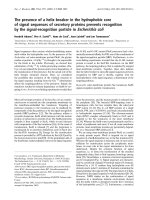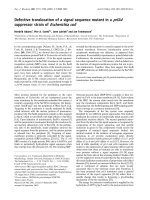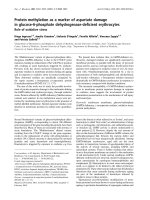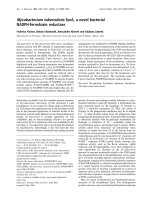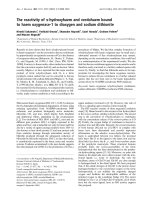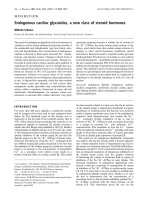Báo cáo y học: " Freeze dried plasma: a French army specialty" pdf
Bạn đang xem bản rút gọn của tài liệu. Xem và tải ngay bản đầy đủ của tài liệu tại đây (111.45 KB, 2 trang )
We read with interest the article by Nascimento and
colleagues [1] on fresh frozen plasma (FFP) in massive
bleedings. We fully agree with their conclusion when they
say that we need immediately available universal donor
AB plasma.
Hemorrhagic shock is the primary cause of avoidable
mortality in combatants. Data from the recent US army
war experience show clearly that in cases of massive
transfusion the transfusion policy strongly impacts
mortality. Namely, for massive bleeding the ratio between
red blood cells and clotting factors should be close to the
composition of whole blood [2].
Plasma is thus essential for massive transfusions. But
FFP use is impractical in uncertain environments such as
a battlefi eld. During military operations, refrigerated
transportation and storage are logistical problems.
awing of FFP takes a long time, with an important loss
of plasma in austere environments. For example, Mabry
and colleagues [3] report that, during the Mogadishu
urban battle, the available FFP was stored in bags that
fractured one-third of the time upon thawing.
For these reasons, the French army has used freeze-
dried and secured plasma (FDSP) since 1994. Plasma
separated from fresh blood of at least ten donors is
lyophilized to produce FSDP. Blood type selection allows
the dilution and neutralization of natural anti-A and anti-
B hemagglutinins. is FDSP is thus compatible with any
blood type. In addition, FDSP is shelf-stable in ambient
temperatures for 2 years and easily rehydrated with
200 ml of water for injections in less than 3 minutes,
allowing immediate provision with the fi rst packed red
blood cells [4].
FDSP contains all clotting factors and proteins. After
more than 2 years storage at ambient temperature, the
fi brinogen and clotting factor levels of FDSP are
equivalent to FFP [4].
e securization process is quarantine (i.e. the plasma is
held until the donor returns and is retested after a period
that is longer than the window period of known viruses).
Plasma as FDSP is thus a logistically superior product,
without compromising hemostatic properties, quickly
available in cases of emergency for any blood type.
© 2010 BioMed Central Ltd
Freeze dried plasma: a French army specialty
Jean Louis Daban
1
, Patrick Clapson
1
, Sylvain Ausset*
1
, Anne V Deshayes
2
and Anne Sailliol
2
See related review by Nascimento et al., />LETTER
*Correspondence:
1
Service d’Anesthésie-Réanimation, Hôpital d’Instruction des Armées Percy,
101avenue Henri Barbusse, BP 406, 92141 Clamart cedex, France
Full list of author information is available at the end of the article
Authors’ response
Bartolomeu Nascimento Jr, Jeannie Callum and Sandro B Rizoli
We thank Daban and colleagues for their insightful
obser vations and agree with the comments on the
challenges to using AB FFP in trauma. Products such as
freeze-dried plasma or lyophilized plasma are appealing
for trauma resuscitation since they have many of the
characteristics of an ideal resuscitation fl uid for bleeding/
coagulopathic patients. Such an ideal fl uid would be easy
to prepare and rapid to administer, contain all clotting
factors, not require blood typing and matching, be free of
infectious and immunological risks and have a long shelf
life. Concerning volume, it is unclear whether the benefi t
of early and aggressive FFP transfusion in massive
traumatic bleeding is related to either clotting factor or
volume replacement with reduced crystalloid exposure.
Since most trauma patients are hypovolemic, large
volumes are often advantageous, but in circumstances
where circulatory overload is a concern, the use of small
volume clotting factor concentrates, including freeze-
dried plasma, would be superior.
We lack experience with lyophilized plasma, which to
our knowledge is available only to military personnel of
some countries. Historically it was implicated in hepatitis
epidemics during the Korean War, but safer preparations
are now available and the interest in this product is
growing, particularly over the past few years. Recent
experience with this product comes from the battlefi eld,
but mostly from animal models [4-6], in which lyo-
philized plasma was found to be equivalent to FFP in
correcting coagulopathy [5,6]. We agree that further
clinical studies with this product are needed.
Daban et al. Critical Care 2010, 14:412
/>© 2010 BioMed Central Ltd
Abbreviations
FDSP = freeze-dried and secured plasma; FFP = fresh frozen plasma.
Competing interests
SBR has received speaker’s fee and honorarium (as member of the Scienti c
Advisory Board) from NovoNordisk A/S, manufacturer of NovoSeven
(recombinant factor VIIa). The other authors declare that they have no
competing interests
Author details
1
Service d’Anesthésie-Réanimation, Hôpital d’Instruction des Armées Percy,
101 avenue Henri Barbusse, BP 406, 92141 Clamart cedex, France.
2
Centre de
Transfusion Sanguine des Armées Jean Julliard, 1 rue Lieutenant Raoul-Batany,
BP 410, 92141 Clamart cedex, France.
Published: 14 April 2010
References
1. Nascimento B, Callum J, Rubenfeld G, Neto J, Lin Y, Rizoli S: Clinical review:
Fresh frozen plasma in massive bleedings - more questions than answers.
Crit Care 2010, 14:202.
2. Spinella PC, Holcomb JB: Resuscitation and transfusion principles for
traumatic hemorrhagic shock. Blood Rev 2009, 23:231-240.
3. Mabry RL, Holcomb JB, Baker AM, Cloonan CC, Uhorchak JM, Perkins DE,
Can eld AJ, Hagmann JH: United States Army Rangers in Somalia: an
analysis of combat casualties on an urban battle eld. J Trauma 2000,
49:515-528.
4. Daban JL, Deshayes AV, Clapson P, Batjom E, Schall JV, Clavier B, Ausset S,
Sailliol A: Le plasma cryodesséché: un produit stable et rapidement
disponible pour les opérations militaires. Société française d’anesthésie
réanimation. Congress (51;2009;Paris). Ann Fr Anesth Reanim 2009,
28:S141-S144.
4. Daban JL, Deshayes AV, Clapson P, Batjom E, Schall JV, Clavier B, Ausset S,
Sailliol A: Le plasma cryodesséché : un produit stable et rapidement
disponible pour les opérations militaires. Société française d’anesthésie
réanimation.Congress (51;2009;Paris). Ann Fr Anesth Reanim 2009,
28:S141-S144.
5. Shuja F, Shults C, Duggan M, Tabbara M, Butt MU, Fischer TH, Schreiber MA,
Tieu B, Holcomb JB, Sondeen JL, Demoya M, Velmahos GC, Alam HB:
Development and testing of freeze-dried plasma for the treatment of
trauma-associated coagulopathy. J Trauma 2008, 65:975-985.
6. Spoerke N, Zink K, Cho SD, Di erding J, Muller P, Karahan A, Sondeen J,
Holcomb JB, Schreiber M: Lyophilized plasma for resuscitation in a swine
model of severe injury. Arch Surg 2009, 144:829-834.
doi:10.1186/cc8937
Cite this article as: Daban JL, et al.: Freeze dried plasma: a French army
specialty. Critical Care 2010, 14:412.
Daban et al. Critical Care 2010, 14:412
/>Page 2 of 2


